
- Permbajtja
- prev
- next
- prev
- next
HIGHLIGHT: PATRICIA URQUIOLA
Early life and career
Spanish by birth, and Italian by choice, Patricia Urquiola was born in Oviedo, Spain 12 May 1961 and studied architecture in Madrid before graduating from the Milan Politecnico in 1989. She was mentored by some of the masters of Italian industrial design: Achille Castiglioni oversaw her graduate thesis, and Vico Magistretti, with whom she designed her first projects. She learned her craft in Italy and opened a studio in Milan in 2001.
Some highlights from her career include her encounter with Maddalena de Padova (1990), her collaboration with Piero Lissoni (1996-2000), and her partnership with Patrizia Moroso (since 1998) which led to the design of the Step Sofa, eventually debuting at the Saloni Milano and launching her into the spotlight at the young age of 40. Amidst all of these accomplishments, she had a stint at Lissoni Associati, beginning in 1993, where she developed furniture for Italian giants Cappellini and Cassina. The Mandarin Oriental Hotel in Barcelona is one of her many architectural projects.
Awards and international recognition
She has won several international prizes and awards including the Medalla de Oro al Mérito en las Bellas Artes (Gold Medal in Fine Arts) awarded by the Spanish Government; Order of Isabella the Catholic, awarded by His Majesty The King of Spain Juan Carlos I; “Designer of the decade” for two German magazines, Home and Häuser, “Designer of the Year” for Wallpaper, Ad Spain, Elle Decor International and Architektur und Wohnen Magazine. She was the Ambassador of the Milan Expo in 2015. She was nominated Art Director of Cassina in September 2015.
Studio
Studio Urquiola was founded in 2001 by Patricia Urquiola and her partner, Alberto Zontone, and it operates in the fields of industrial product design, architecture (hotels, retail spaces, residences, exhibitions and installations), art direction and strategy consulting.
Work and clients
Patricia Urquiola starts each project by building an empathic connection with the user that will eventually interact with her designs, something she learned from Achille Castiglioni, establishing the “fundamental element” as he used to call, the basis of each project which always keeps her on track and accompanies her whole design process: thinking spaces or objects in relation to people. Pushing the limits of research and technology, Patricia Urquiola constantly experiments and dares to move towards better design and architecture, following her earlier mentors’ teachings such as Vico Magistretti and Maddalena de Padova. Used to confront complex processes, working with scales from micro to macro, she works with the available technology to go beyond the limits of what has been already experimented.
Studio Urquiola is frequently asked to design not only objects and architectures but also to think about the future of mobility, workplace and production cycles. Creating links between craftsmanship and industrial research, the heritage together with innovation and technology, Patricia Urquiola also drives companies she works with to upcycle once-waste material and tries to re-image entire processes leading them to change, evolution and innovation.
Patricia Urquiola believes in an original design point of view merging humanistic, technological and social approaches. Her design thinking is the intersection of challenges and breaking prejudices, finding unexpected connections between the familiar and the unexplored.
Most iconic projects
New Mandarin Oriental Hotel
Passeig de Gràcia is an iconic street in the heart of Barcelona, home to some of the world’s most vibrant examples of modernist architecture. The Mandarin Oriental hotel is housed in the former Banco Hispano-Americano, an elegant mid-20th century building. The 2010 project entailed the renewal of the interiors, by creating a surprising space on different levels. A bright, hanging access ramp crosses a courtyard, leading to the hotel entrance. Separated by metal grids, it still allows a glimpse into the hall and lobby. 3D textured walls confers the space a sense of depth. Most of the furniture is custom designed for the hotel, produced by leading Italian and Spanish manufacturers.
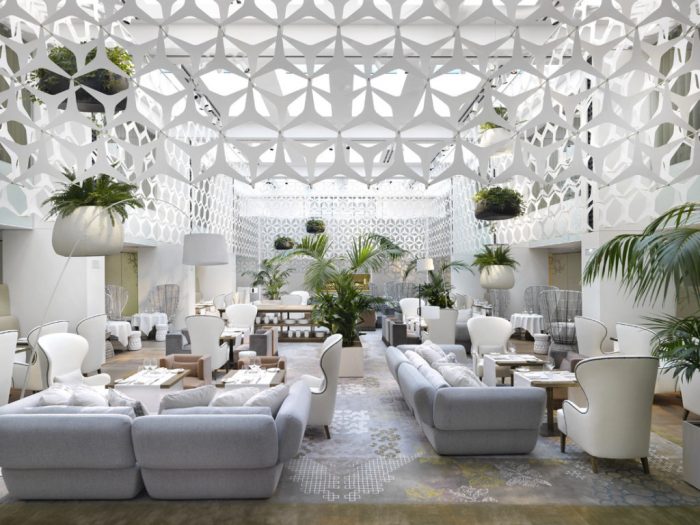
Missioni Store Milan
Missoni’s Milanese flagship store is a unique reinterpretation of the brand’s codes and language. The interior design plays with tones and textures of different materials, from wood to etched mirrors and from copper-finish metal to polychrome lacquers. The outcome is a collage of stripes and zigzags, motifs dilated and interpreted on boiserie, panels, walls and ceilings. They create an environment which is evocative and luminous, designed to highlight and give prominence to each piece of the Missoni collections.

W Vieques Hotel
Vieques was the choice location for the W Hotel chain’s first Caribbean property, in 2010. The project was designed to be airy and whimsical: this was principally achieved through a daring combination of pure and recycled materials, organic forms, and avant-garde furniture. It creates a contrasting dialogue, an eclectic combination between the furnished interiors and the surrounding beauty of Puerto Rico’s natural landscapes.

Marienturm and Marienforum
The interior design for Marienturm and Marienforum (two new towers in the heart of Frankfurt’s financial district) is influenced by the nearby Taunusanlage Park. It unifies two different atmospheres inside the buildings, a relationship between Work and Nature. The Marienturm’s interiors focus on communicative zones. A 17-metre-high lobby acts as a transit zone between working environments and nature, blended by contrasting materials (wood, stone, marble, metal) and unique patterns and textures. Focal point from inside and outside, a wall (ash wood blocks sticking out from the vertical alignment) create a strong, pixel-like pattern. Marienforum follows the same concept, with different materials, while a diagonal pattern unites both designs. Walnut wood ceiling and counters play with the same diagonal pattern.
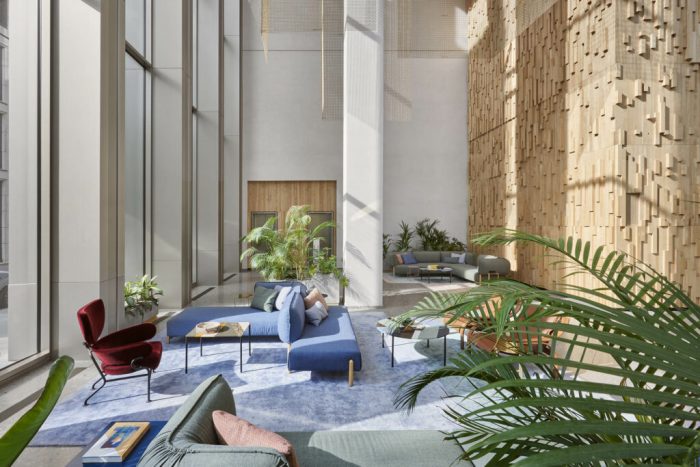
Most iconic products
Patcha
Designed for cc-tapis, Patcha collection interprets the concept of gesture through the imperfect assemblage of spontaneous collages, a captivating composition of color and pattern. Patcha utilizes the patch-work spontaneity of mixed-media collage by overlapping and assembling strips of mint green, lavender, taupe, burgundy and speckled technicolor fields.
A myriad of textures, pile heights and colors define the character of each rug. Sustainable dyeing techniques using less water and novel materials like cast-off silk from Indian Sari production are utilized to create Patcha rugs. The speckled technicolor fields are made by using left-over silk and surplus wool taken from the production from other rugs.
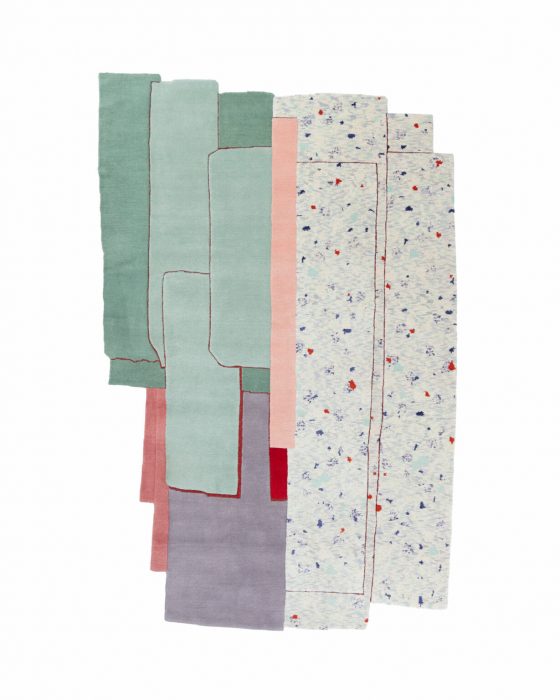
MarVles
MarVles is a happy Milanese encounter with Valextra and Budri: a multidisciplinary project, resulting in a unique blend of craftsmanship and technology.
Patricia Urquiola reinterprets Valextra iconic Iside through a series of 19 limited edition bags.
The project comprises three collections, each featuring a distinctive leather intarsia design, a new marble handle and a marble clasp. The Fuse, with organic curves that suggest rock formation; the Bow, characterized by a play of geometries through intersecting arches; and the Edge, an extreme angular motif that is part futurist, part art-deco. The whole collection was deeply inspired by agate, and its natural layers were reproduced in marble.
A timeless colour palette of leathers dominates the collection: organic shades that reference the natural marble hues, plus a series of pop colours from Valextra’s archives.

Veneer
In Veneer, the rhythm of the decoration ripples over the volumes, creating a pleasant wave effect. The movement of the texture reinterprets the grain of wood in a controlled way, almost creating an optical illusion thanks to the fluid lines floating over the surface. Veneer is designed by Patricia Urquiola as a dreamy pattern. Its application is further testimony of Alessi expertise in metal working.
The Veneer collection includes bowls, trays, napkin holders and hermetic glass jars in various sizes.
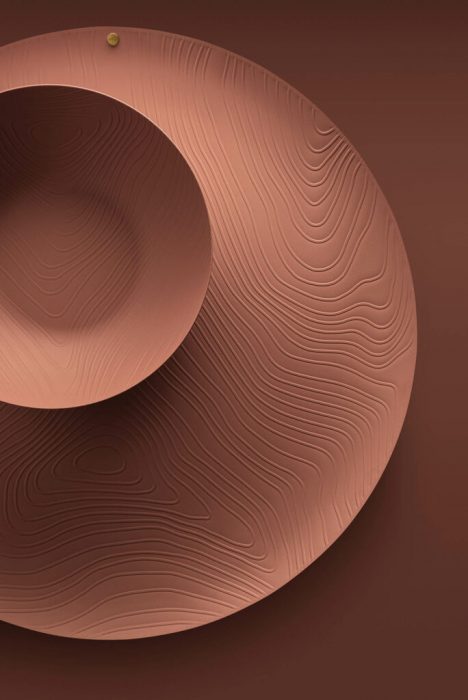
Lud'o
A tribute to Ludovico Magistretti, the Lud’O lounge chair designed for Cappellini recreates the softness of a feather-padded jacket. The design concept is simple yet innovative: a supporting structure wearing a soft “dress” upholstery that can be easily changed depending on the seasons, occasions or mood.
A range of five “dress” alternatives includes a recycled nylon sports upholstery and recycled PET material, created entirely from recycled plastic and marine debris.
The plinth features deliberately exasperated proportions forming a large swivel cone, available in aluminum. There is also a version based on 4 spokes and 4 legs made of natural or dyed wood. The body, shaped by a rotational mold, is made of recycled and durable plastic. The structure is deliberately essential because it is the “dress” that the armchair is “wearing” that makes the product, the quilted effect upholstery its distinctive feature. The product is completed with a matching footrest with the same concept.
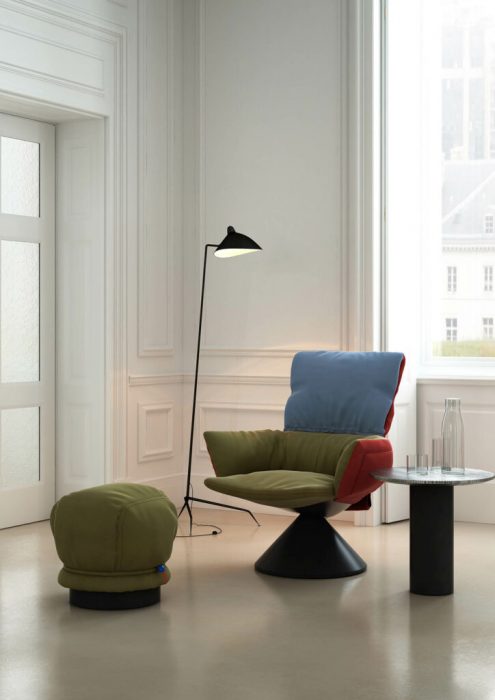
Museum exhibitions
-2003 Galleria Alina Espacio, Mallorca, Spain.
-2003 Pakhuis Amsterdam, The Netherlands.
-2004 Interieur, Kortrijk, Belgium.
-2005 Ideal House, IMM, Cologne, Germany.
-2006 “P.U. Ajuar”, Casa Pasarela, Madrid, Spain.
-2006 “Pelle d’asino – Donkey Skin”, Verona, Italy.
-2007 “Dance No.2”, Kölnischer Kunstverein, Art Gallery, Cologne, Germany.
-2007 “Dance No.3”, SuperSpace, Belgrade, Serbia.
-2008 “Chasen”, Flexibility, Le Nuove, Turin, Italy.
-2008 “Purely Porcelain”, London Design Museum, London, UK.
-2008 “No-where-Now-Here”, Laboral, Contemporary Art Museum, Gijon, Spain.
-2009 Muzeum Sztuk Użytkowych, Poznań, Poland.
-2010 “Macrosterias”, Art Basel, Switzerland.
-2010 “Cosas”, Valencia, Spain.
-2010 “Contempling The Void”, Guggenheim Museum, New York, NY, USA.
-2010 Art Basel 41, Basel, Switzerland.
-2011 “Ossimori”, Casabella Lab, Milan, Italy.
-2011 “All Ambiq”,Design Miami, Miami, FL, USA.
-2011 “Interior Trends”, IMM, Cologne, Germany.
-2011 Luminaire Miami, Miami, FL, USA.
-2011 “All Ambiq”, Venice Art Biennale, Venice, Italy.
-2011 “Creative Junctions”, National Museum of China, Beijing International Design Triennial, Beijing, China.
-2011 Luminaire Chicago, Chicago, IL, USA.
-2011 “O’Clock- Design del Tempo, Tempo del Design”, Triennale Museum, Milan, Italy.
-2012 “All Ambiq”, Museum of Arts and Design, New York, NY, USA.
-2013 “O’clock – time design, design time”, CAFA Art Museum, Beijing, China.
-2013 “Glasstress”, MUDAC, Museum for Design and Contemporary Applied Arts, Lausanne, Switzerland.
-2014 "Gathering" exhibition by Li Edelkoort & Philip Fimmano approaches, Design Museum Holon
-2017 "Patricia Urquiola: Between Craft and Industry", Philadelphia Museum of Art, Philadelphia, USA
Referred to: wikipedia, patriciaurquiola.com